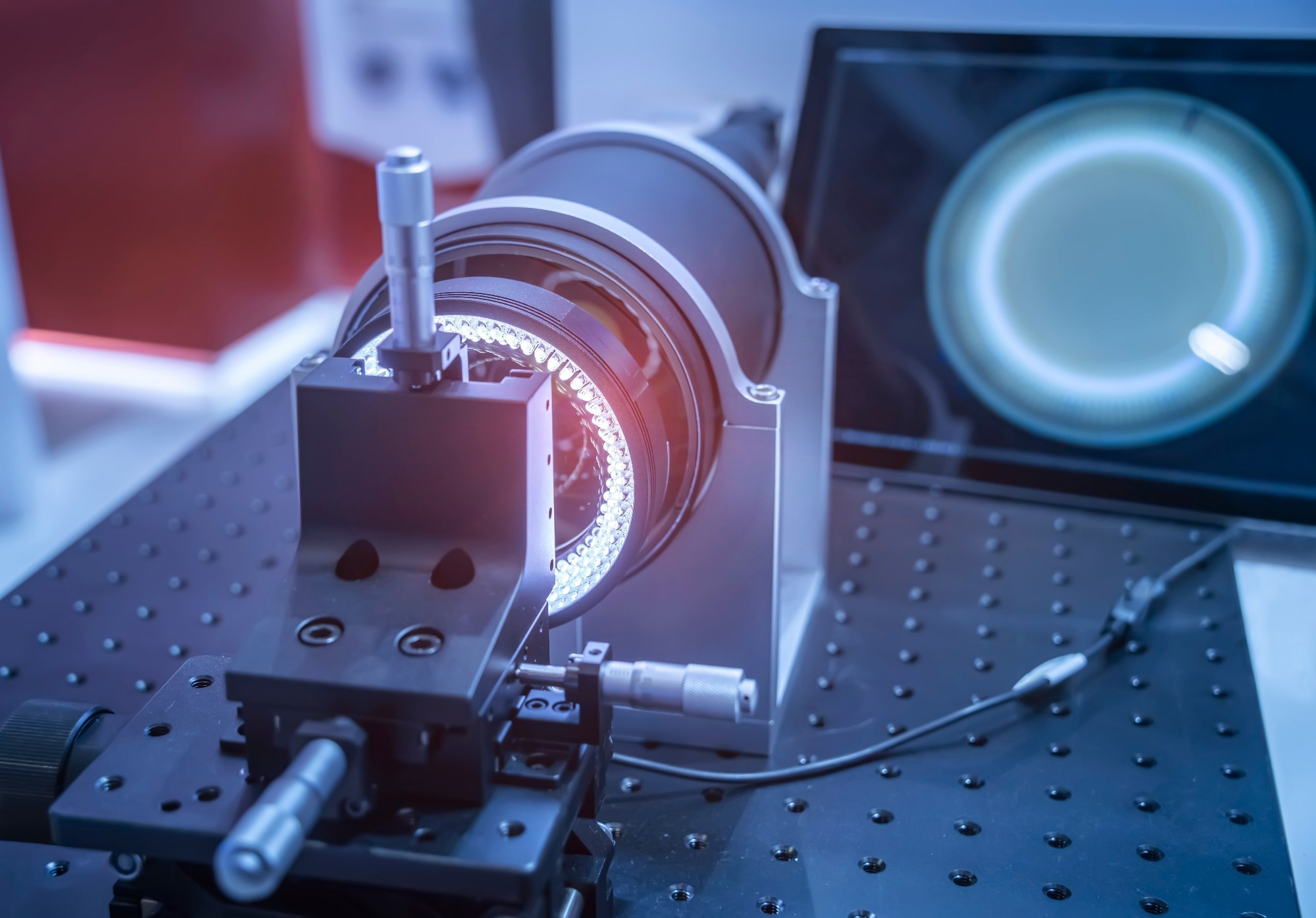 By Atif SuhailReviewed by Lexie CornerUpdated on Dec 20 2024
By Atif SuhailReviewed by Lexie CornerUpdated on Dec 20 2024Optical sensors detect and measure light intensity by converting light rays into electrical signals. These sensors are connected to electrical triggers that respond to changes in light. Optical sensors are used in various devices, including computers and motion detectors.

Image Credit: asharkyu/Shutterstock.com
Types of Optical Sensors
The primary principle behind optical sensors is the transmission and reception of light. Light that is reflected or interrupted by a target object is analyzed using several optical devices, depending on the type of material, such as wood, metal, plastic, or transparent and colored products.
Optical sensors rely on various light sources that must be monochromatic, durable, and compact to ensure reliable performance. The two most commonly used light sources are Light-Emitting Diodes (LEDs) and Light Amplification by Stimulated Emission of Radiation (LASER).
Optical sensors can be placed either externally or internally within a device. External optical sensors, also known as extrinsic sensors, gather and transmit a specific quantity of light. In contrast, internal or intrinsic sensors are typically used to measure bends or changes in the direction of light. Intrinsic sensors are often embedded within optical fibers or other devices.
The choice of optical sensors depends on the application. For example, in photoconductive devices, optical sensors measure resistance by converting changes in incident light into changes in resistance. In solar cells, sensors convert incident light into output voltage, while photodiodes convert incident light into output current. Similarly, phototransistors, a type of bipolar transistor, function like photodiodes but offer internal gain. Below are some common types of optical sensors and their functions:
Through-Beam Sensors
In through-beam sensors, the transmitter and receiver are positioned opposite each other. When the light beam is interrupted, the receiver interprets the interruption as a switch signal. These sensors can cover significant operating distances and accurately detect object surfaces, structures, and colors.
Retro-Reflective Sensors
Retro-reflective sensors have a transmitter and receiver housed within the same system. Like through-beam sensors, these sensors operate via a switching mechanism and can cover large operating distances. They can independently and accurately detect any object that interrupts the light beam.
Diffuse Reflection Sensors
In diffuse reflection sensors, both the receiver and transmitter are integrated into a single system. These sensors detect light reflected off the surface of objects, enabling accurate detection based on reflected light.
Latest Advancements in Optical Sensor Applications
Biomedical and Healthcare Applications
Optical sensors are increasingly used in biomedical and healthcare applications for disease diagnosis, drug discovery, and monitoring biological processes. These sensors enable the detection of disease biomarkers, infectious agents such as bacteria and viruses, and human metabolites like hormones and neurotransmitters.
Recent advancements, including label-free optical methods and fluorescence-based detection, have improved the ability to identify diseases like cancer, detect autoimmune antibodies, and study live-cell protein activities.
For example, a green-synthesized gold nanoparticle-based optical biosensor was recently developed to detect the CD44 cancer biomarker. This biosensor demonstrates high sensitivity and specificity, with a detection limit of 0.111 pM across a wide concentration range (42.9 aM to 100 nM), providing a cost-effective and eco-friendly approach.
Fiber-optic and surface plasmon resonance biosensors are also used to measure therapeutic drugs, detect toxins, and analyze microbiological and genomic data. These advancements demonstrate the growing importance of optical sensors in healthcare and biotechnological research.
Agricultural and Veterinary Applications

Image Credit: Hryshchyshen Serhii/Shutterstock.com
In agriculture and veterinary science, optical sensors are used to detect pathogens, pesticide residues, and crop diseases, as well as to monitor the quality of food products such as milk, meat, fruits, and vegetables. They are also used to analyze soil quality and identify contaminants.
For example, methyl-parathion (MPT), a widely used organophosphate pesticide, can be detected using a tapered fiber optical sensor combined with the enzyme acetylcholinesterase. Similarly, sulfadimidine, a drug residue found in water and dairy products, has been effectively identified using an evanescent wave optical sensor.
Advanced methods, including photonic crystals and tapered optical fibers, have further enhanced sensitivity for detecting urea and pathogens. Paper-based algal biosensors have also been developed to identify nanoencapsulated pesticides, offering practical tools for ensuring food safety and addressing agricultural challenges.
The Revolutionary Role of Lasers in Agriculture
Industrial Process and Monitoring
Optical sensors are widely applied in industrial processes to improve process control, quality assurance, and safety in sectors such as bioprocessing, wastewater analysis, and food production.
In tissue engineering, optical sensors enable real-time monitoring of cellular activities. In pharmaceutical production, they are used to assist with drug discovery and development. Additionally, they are critical in nanoscale biomedical applications and optical device fabrication.
In the poultry industry, optical sensors provide a reliable method for detecting antibiotics, helping address concerns about antibiotic resistance. Their adaptability to nanoscale biomedical applications and optical device fabrication underscores their usefulness across various industrial processes.
Military and Defence
In military and defense sectors, optical sensors are used for detecting biological and chemical threats, monitoring soldier health, and improving operational readiness. Technologies such as luminescence, fluorescence, evanescent wave, and surface plasmon resonance (SPR) sensors are applied to identify pathogens like Bacillus anthracis and Clostridium botulinum neurotoxin.
Optical sensors are also effective in detecting chemical agents, including sulfur mustard and explosives such as 2,4,6-trinitrotoluene (TNT), using technologies like graphene oxide-based and single-walled carbon nanotube biosensors. These advancements demonstrate the role of optical sensors in improving defense capabilities and preparing for biological, chemical, and explosive threats.
Future of the Optical Sensor Industry
The optical industry is expected to grow significantly in the coming years, driven by advancements in materials science, nanotechnology, and artificial intelligence (AI). Innovations in miniaturization and integration are enabling the development of compact, high-performance sensors for wearable devices, smartphones, and healthcare systems.
Emerging technologies like quantum optics and photonic sensors are enhancing sensitivity and precision, creating new opportunities in secure communications, quantum computing, and advanced imaging. The global optical sensor market is also seeing growth in areas such as fiber optics, photonics, and machine vision.
The use of AI for real-time data analysis is transforming industries, including autonomous vehicles, smart cities, and personalized healthcare. As demand increases across sectors such as telecommunications, aerospace, and environmental monitoring, optical sensors are expected to remain central to technological advancements.
Leading companies like Texas Instruments, STMicroelectronics, and Hamamatsu Photonics are continuously advancing optical sensor technology. For example, Hamamatsu has developed CMOS sensors for high-speed imaging, which are widely used in scientific research and industrial applications.
References and Further Reading
Gu, H., Wang, L. (2022) A High-Detection-Efficiency Optoelectronic Device for Trace Cadmium Detection. Sensors. https://doi.org/10.3390/s22155630
Veettil, TCP., Wood, BR. (2022) A Combined Near-Infrared and Mid-Infrared Spectroscopic Approach for the Detection and Quantification of Glycine in Human Serum. Sensors. https://doi.org/10.3390/s22124528
Umapati, R., et al. (2022) Advances in optical-sensing strategies for the on-site detection of pesticides in agricultural foods. Trends in Food Science and Technology. https://doi.org/10.1016/j.tifs.2021.11.018
Saha, S. (2022) Optical Sensor Market. [Online] Future Market Insights. Available at: https://www.futuremarketinsights.com/reports/optical-sensor-market
Pirzada, M., Altintas, Z. (2020) Recent Progress in Optical Sensors for Biomedical Diagnostics. Micromachines.. https://doi.org/10.3390/mi11040356
Regtien, P., Dertien, E. (2018) Optical sensors. Sensors for Mechatronics. https://doi.org/10.1016/B978-0-12-813810-6.00007-0
Singh, A. K.; Mittal, S.; Das, M.; Saharia, A.; Tiwari, M. (2023). Optical Biosensors: A Decade in Review. Alexandria Engineering Journal. https://www.sciencedirect.com/science/article/pii/S1110016822008249
Ashikbayeva, Z.; Bekmurzayeva, A.; Myrkhiyeva, Z.; Assylbekova, N.; Atabaev, T. S.; Tosi, D. (2023). Green-Synthesized Gold Nanoparticle-Based Optical Fiber Ball Resonator Biosensor for Cancer Biomarker Detection. Optics & Laser Technology. https://research.nu.edu.kz/en/publications/green-synthesized-gold-nanoparticle-based-optical-fiber-ball-reso
Singh, S.; Kumar, V.; Dhanjal, DS.; Datta, S.; Prasad, R.; Singh, J. (2020). Biological Biosensors for Monitoring and Diagnosis. Microbial biotechnology: basic research and applications. https://pmc.ncbi.nlm.nih.gov/articles/PMC7340096/
Bakhshpour, M.; Göktürk, I.; Gür, S. D.; Yılmaz, F.; Denizli, A. (2022). Sensor Applications for Detection in Agricultural Products, Foods, and Water. Pesticides Bioremediation, Springer. https://link.springer.com/chapter/10.1007/978-3-030-97000-0_12
Ahmed, I.; Jiang, N.; Shao, X.; Elsherif, M.; Alam, F.; Salih, A.; Butt, H.; Yetisen, AK. (2022). Recent Advances in Optical Sensors for Continuous Glucose Monitoring. Sensors & Diagnostics. https://pubs.rsc.org/en/content/articlelanding/2022/sd/d1sd00030f
Li, Y.-C. E.; Lee, I.-C. (2020). The Current Trends of Biosensors in Tissue Engineering. Biosensors. https://pmc.ncbi.nlm.nih.gov/articles/PMC7459738/
Pohanka, M. (2019). Current Trends in the Biosensors for Biological Warfare Agents Assay. Materials. https://www.mdpi.com/1996-1944/12/14/2303
Nahar, S.; Pithawa, D.; Bhardwaj, V.; Rawat, R.; Rawat, A.; Pachlasiya, K. (2023). Quantum Technology for Military Applications. Quantum Computing in Cybersecurity. https://www.wiley.com/en-us/Quantum+Computing+in+Cybersecurity-p-9781394166336
Venketeswaran, A.; Lalam, N.; Wuenschell, J.; Ohodnicki Jr, P. R.; Badar, M.; Chen, K. P.; Lu, P.; Duan, Y.; Chorpening, B.; Buric, M., Recent Advances in Machine Learning for Fiber Optic Sensor Applications. (2022). Advanced Intelligent Systems. https://onlinelibrary.wiley.com/doi/full/10.1002/aisy.202100067
Kagawa, K.; Horio, M.; Pham, A. N.; Ibrahim, T.; Okihara, S.-i.; Furuhashi, T.; Takasawa, T.; Yasutomi, K.; Kawahito, S.; Nagahara, H. (2022). A Dual-Mode 303-Megaframes-Per-Second Charge-Domain Time-Compressive Computational Cmos Image Sensor. Sensors. https://www.mdpi.com/1424-8220/22/5/1953
Disclaimer: The views expressed here are those of the author expressed in their private capacity and do not necessarily represent the views of AZoM.com Limited T/A AZoNetwork the owner and operator of this website. This disclaimer forms part of the Terms and conditions of use of this website.